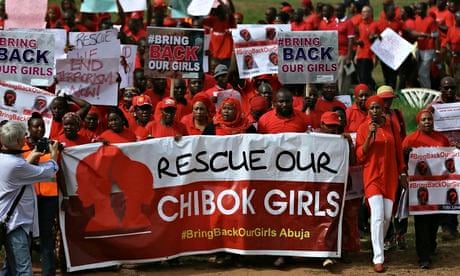Imagine if a single teenage girl was abducted from her boarding school dormitory in the UK. There would have been a Madeleine McCann-style media frenzy as soon as the news broke, with 24-hour live feeds from the school gates complete with pundits scrambling to TV studios to pontificate. Images of the victims would have flashed worldwide and politicians would have been forced to respond.
The comparative silence surrounding the original kidnapping of hundreds of girls from Chibok, in north-eastern Nigeria, might have seemed surprising, except that it happened in Africa. As a consequence, it was at first treated like so much other news from Africa – or at least news with no celebrity angle – the story was ignored or just told in a cursory and often inaccurate way. For the first week or so, there were some occasional mentions but it was all the usual vague confusion; the numbers of girls kept changing and there was a muddle about who was actually present. Was it only the girls from the science block that had been counted, or were the arts students also in the missing total? Did they include the extra exam candidates visiting the school? Even today it is uncertain whether the figure of 223 abducted pupils is correct.
Eight days after the abduction, a lawyer in Abuja, Ibrahim Abdullahi, created the hashtag #BringBackOurGirls to express the growing anger at the woeful government response. Over the next 10 days, the Twitter bandwagon gained worldwide momentum, soon passing a million tweets. It was boosted by participationfrom big names such as Michelle Obama and Malala Yousafzai. But online campaigns were not a replacement for other protests. The parents and their supporters have been mobilising an ongoing series of street demonstrations in the capital and elsewhere, urging the government to act.
Even when the online message went viral there were further problems. The image used to publicise the social media campaign was apparently a picture of three of the victims. Yet it subsequently emerged that the girls featured were from Guinea Bissau – a thousand miles away – and that the picture of them had been taken in 2000, so these girls had nothing to do with Nigeria, and were probably in their late 20s by now. Once again it was an example of sloppy reporting on Africa.
Social media campaigns (such as Kony2012) are frequently dismissed as superficial and a displacement for real engagement – labelled "slacktivism". Yet, despite some difficulties, #BringBackOurGirls does appear to be a case where the worldwide outcry voiced through Twitter has had a genuine impact and promoted meaningful action. It has put the story into the mainstream, largely because it is now framed as a simple humanitarian drama – "horrible terrorists snatch innocent girls". But, crucially, this produced a wider indignation that the government response to the terrorists was inadequate.
The Nigerian government was forced to act and it gave other governments a lever to press. It is shocking that this process took two weeks, but interesting that the response was prompted by social media. In the 21st century, the "CNN effect" has been replaced by the Twitter effect. And an example of the power of the hashtag was when a US military spokesman warned that American forces could be "tweeted into combat" – such was the impetus of the international pressure generated by social media.
It was not only governments and international figures that rushed to retweet the message. NGOs with their increasingly sophisticated social media operations were using the hashtag to promote wider awareness. Groups focusing on gender issues as far away as Malawi were using it to encourage female school attendance in general. And another NGO, Lightup Foundation, with a completely different perspective, used the campaign to highlight its work on assisting victims of trauma.
Yet in contrast to Kony2012, this is a campaign which was not initiated by a western NGO. It arose from the concerns of Nigerian grassroots and it has been this pressure upon Goodluck Jonathan and his government that has been the key dimension. Other large NGOs have joined the social media campaign, from Amnesty International to Christian Today. But the reverberation of the message by other groups is secondary to the way that it has been used to pressure decision-makers (locally and internationally) into responding. There are even suggestions that it will affect next year's election in Nigeria. With Kony2012 there was no such connection. That was an NGO creation, with no clear message for action.
And there are further media twists to this episode. It was more than two weeks before Boko Haram even admitted responsibility for the abduction. Is this the latest terror tactic: eerie silence? Just like the Malaysian airliner, flight MH370, it creates a vacuum for more crazy speculation. And when Boko Haram did accept responsibility, it also used the media to parlay, recording a video of its demands and showing images of the Muslim conversion of certain captives.
Sadly, in northern Nigeria violence has become a way of life. Many massacres and previous abductions were almost ignored by media and officialdom. The story of the girls from Chibok has become the exception. Boko Haram carried out a massacre on 5 May in north-eastern Nigeria. 375 inhabitants were killed and many others had to flee – but this shocking attack hardly made the news agenda. Normal service was resumed.
Suzanne Franks is the author of Reporting Disasters Famine, Aid, Politics and the Media.
Read more stories like this:
Making Twitter work for international organisations
Top tips on using the media to aid development
Top tweeters on youth empowerment in Africa
Join the community of global development professionals and experts. Become a GDPN member to get more stories like this direct to your inbox

Comments (…)
Sign in or create your Guardian account to join the discussion